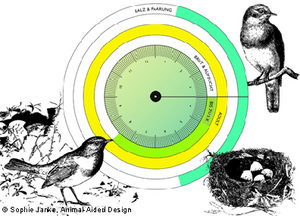Application of the Animal-Aided Design (AAD) Method

Due to climate change cities are increasingly important for the protection of animals. For example, about 40 of the 90 mammal species living in Switzerland have been observed in Zurich-nearly half. Besides mammals there are many other species in the city such as birds and wild bees which find suitable living conditions there. In almost every group of animals there are species which can also live in cities. The variety of species may even surpass the diversity of the surrounding landscape, if this is intensively farmed.
As climate change threatens many species, this function of cities as a refuge will become more and more important in the future. However, densification and standard types of building renovations which only focus on the building itself (i.e., instead of also supporting habitat) are contributing to the further reduction of animal species in cities, as there is less and less unused space. This trend is exacerbated by climate change. To ensure animals' survival, it won’t be enough in the future to expect that animals can survive through park space alone, as these areas were not planned with their consideration in mind.
Current open space planning isn’t geared towards systematically enabling the occurrence of animals in cities. The planning method "Animal-Aided Design"®, briefly AAD, allows the creation of suitable refuge areas for animal species within the framework of climate change planning. Animal-Aided Design® is a method which has been developed to include the basic needs of animals in planning processes.
The goal of AAD is to create a habitat for a viable population in the planning area as well as ensure the integration of animals with a larger radius of action into a population. In a precursor project funded by the Bavarian State Ministry of the Environment and Consumer Protection, examples were used to demonstrate theoretically how AAD can be used for specific planning tasks.
In the current project, practical examples will be used to evaluate the method regarding its practicality and intended outcomes. The implementation is supported by GEWOFAG Holding GmbH and the city of Ingolstadt. The projects of the partners are in various stages of implementation. This makes it possible to test the application of AAD in different implementation phases within the framework of a 3-year project.